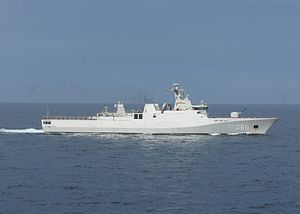Over the weekend, reports emerged about Indonesia’s role in pushing for patrols among Southeast Asian countries in the South China Sea. For some, the reports might feed into a narrative that Indonesia is hardening its position in the South China Sea and exercising greater leadership in Southeast Asia on this front. In fact, there is both little new in Indonesian rhetorical calls for patrols of this ilk and no specifics that suggest a significant change in Jakarta’s long-held position on the South China Sea or of wider regional sentiment on the idea of patrols more generally.
The idea of patrols among Southeast Asian states in the South China Sea is far from new, as I have noted before in these pages. Regional states have been discussing the idea for years. Southeast Asian countries as well as ASEAN as a regional bloc have also been discussing patrols with Beijing, Washington, and other major powers as well over the years (See: “What’s Behind the New ASEAN-China Maritime Exercise?”).
The notion of Indonesia itself mulling or discussing South China Sea patrols with Southeast Asian states and others is not new either. Jakarta’s South China Sea approach, which I’ve dubbed a “delicate equilibrium,” seeks to balance both diplomatic and regional efforts with China and other ASEAN countries with its own security, legal, and economic measures to preserve its own interests (See: “Indonesia’s South China Sea Policy: A Delicate Equilibrium”). Patrols with other countries is not inconsistent with such an approach.
It has therefore been little surprise that we have seen Jakarta suggest patrols among Southeast Asian states and with others as well over the past few years. At the minilateral level in Southeast Asia, there had been discussion about trilateral patrols in the Sulu-Sulawesi Seas between Indonesia, Malaysia, and the Philippines eventually broadening out to parts of the South China Sea (See: “Confronting Threats in the Sulu-Sulawesi Seas: Opportunities and Challenges”). In addition, in previous iterations of the Indonesia-Australia “2 +2” meeting, there have also been mentions as well about bilateral patrols in the South China Sea. Ryacudu’s comments this week are thus just the latest in a line of such statements rather than a groundbreaking development.
So when Reuters reported on March 17 that Indonesian Defense Minister Ryamizard Ryacudu mentioned following an Indonesia-Australia meeting that Jakarta had been discussing patrols with other Southeast Asian states, this was hardly news. Indeed, Ryacudu’s comments focused less on new ideas about joint or coordinated patrols on an expanded basis but just having countries facing the South China Sea patrolling within their own exclusive economic zone (EEZ), which would already cover part of the South China Sea. That speaks to a broader issue with such proposals for patrols: the devil lies in the details, but the details are often overlooked amid the headlines.
Furthermore, while Ryacudu did touch on how there had been discussions about such patrols, he unsurprisingly did not mention how those discussions have advanced or even mention specific countries. That alone should reinforce a point I’ve made before: talking about patrols is much easier to do (and is done much more frequently) than actually acting on them, whether in a low-key fashion or even in a highly-public way. There are stubborn realities that need to be confronted here, including, among others, the limited capabilities of Southeast Asian states, the longstanding desire not to upset peace and stability, and the differences in views that need to be reconciled domestically. Indonesia is not immune from these as well.
There are also specifics that need to be ironed out as well to properly manage these engagements if they are to be evaluated in principle or acted on in practice, including where exactly they are being held, what the nature of the patrols are (joint, coordinated, or combined, which can all have important distinctions though they are used interchangeably), and how to communicate this to the wider public. That we have heard much more about general patrols rather than specifics is testament to how difficult such challenges are to overcome. In his remarks, Ryacudu also mentioned not just the South China Sea, but also the Malacca Strait and the Sulu Sea as well, which present their own opportunities and challenges in this respect and represent different degrees of regional collaboration.
Fourth and finally, while discussing the specifics of and the feasibility around such patrols, it is worth being candid about their utility. Joint patrols may make sense for Southeast Asian states in order to demonstrate presence and illustrate that regional actors are willing to and capable of providing for the security of their own waters. Beijing, for its part, no doubt sees these patrols as important enough for it to engage on as well, seeing that outside actors are looking at them as a means of what it terms “outside interference.”
But given the vast asymmetry of capabilities in China’s favor, patrols of this ilk will in fact do very little to affect a change in Chinese assertive behavior that allow it to have a growing ability to control the South China Sea, which Beijing can then choose to exercise to secure its interests at the expense of others. Not unlike other initiatives such as the work on a binding code of conduct in the South China Sea, it is important to be attentive to both the value and limitations of individual measures to confront the real strategic challenge (See: “Will a China-ASEAN South China Sea Code of Conduct Really Matter?”).
































